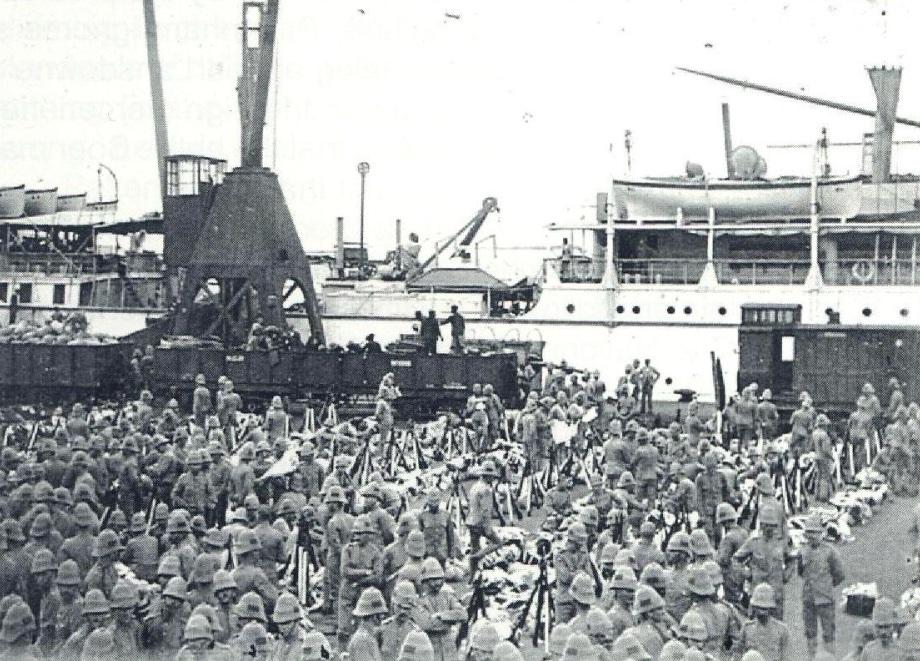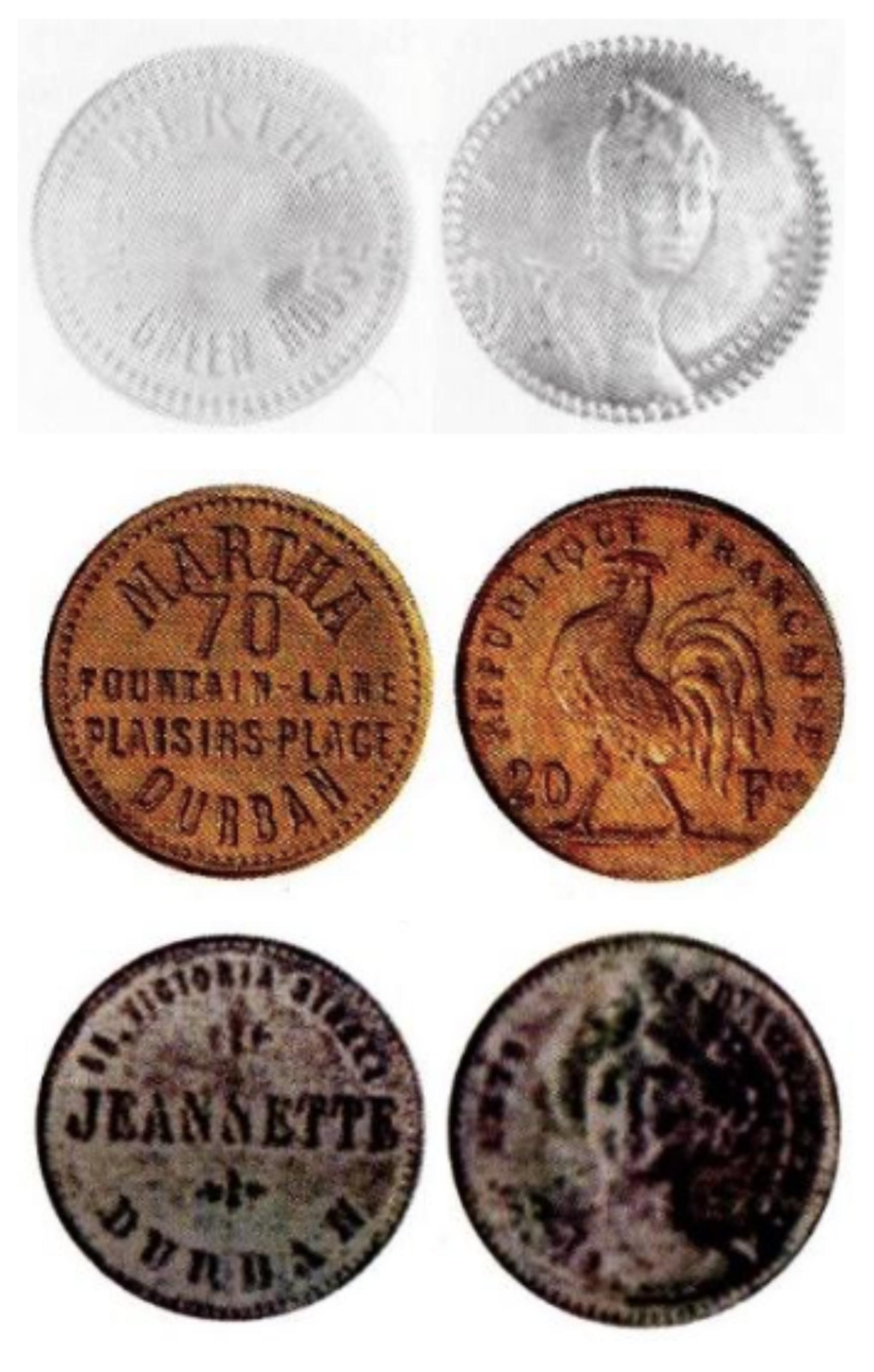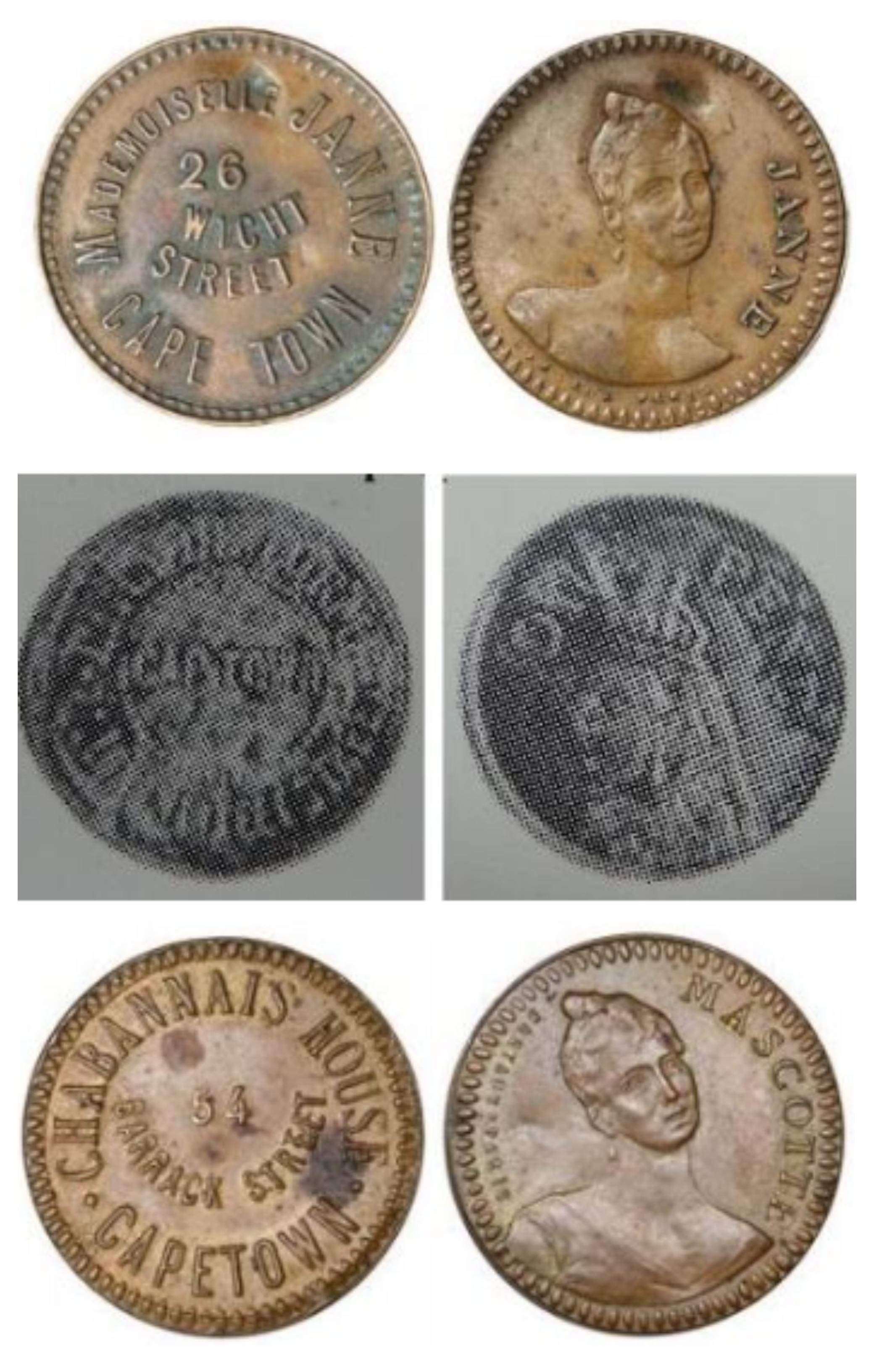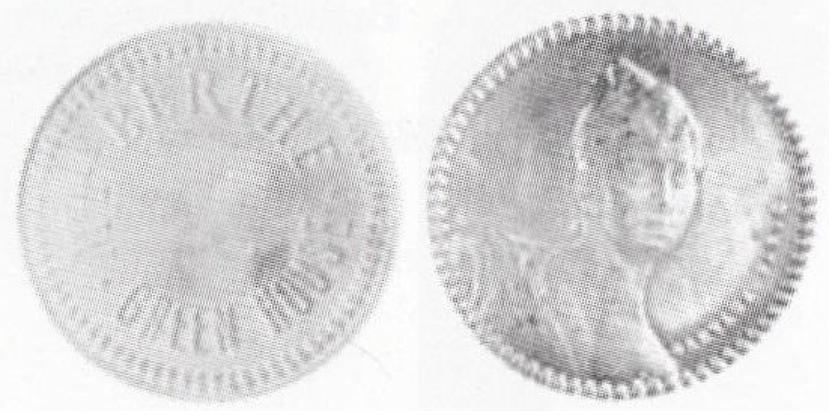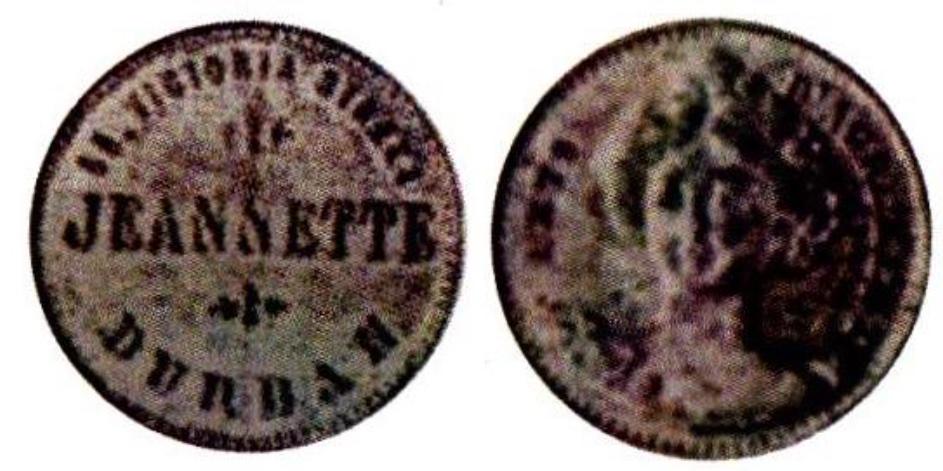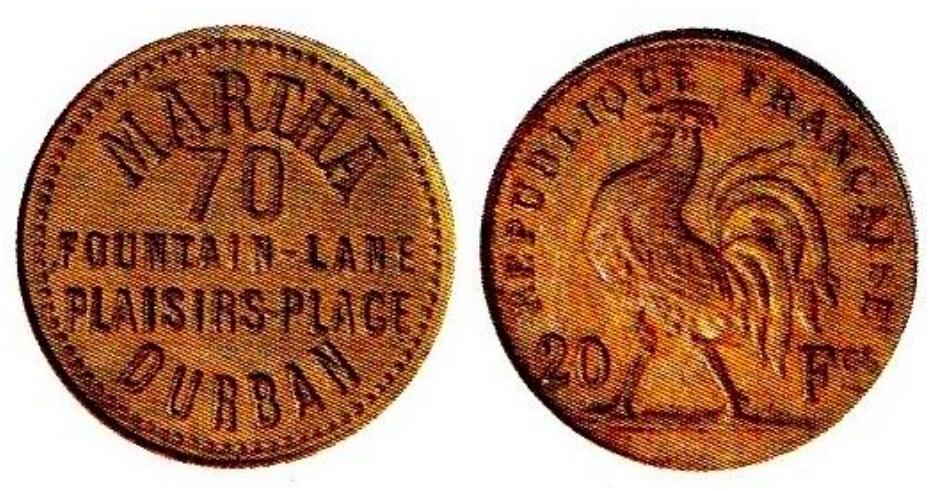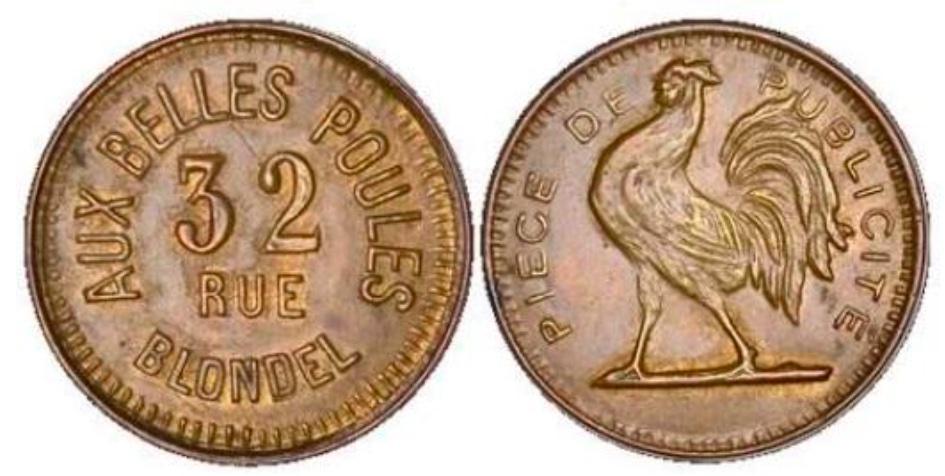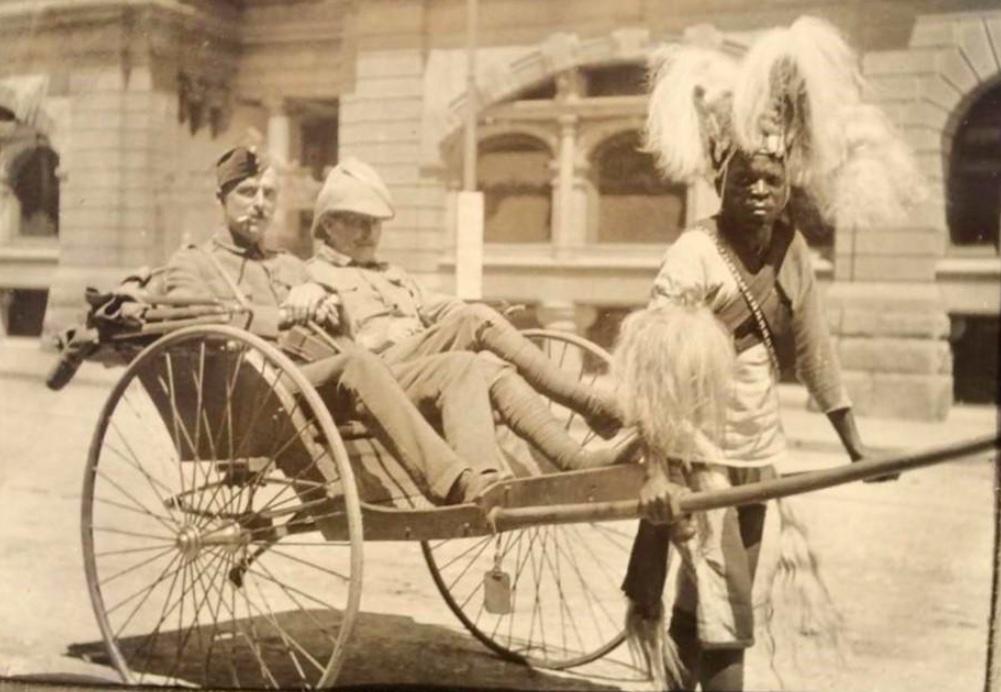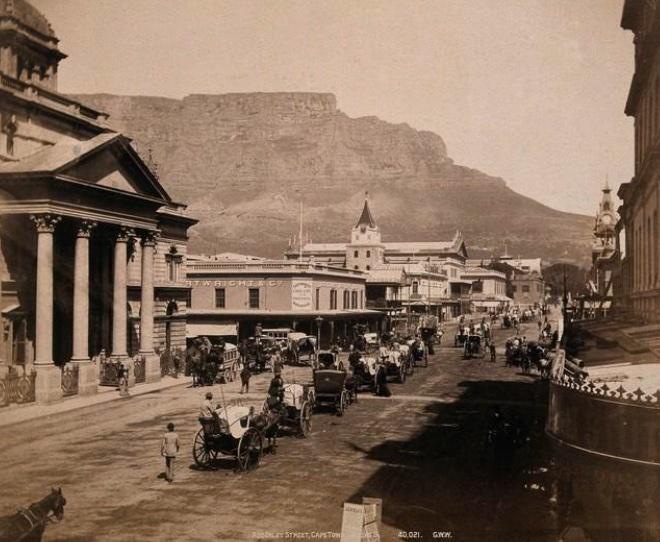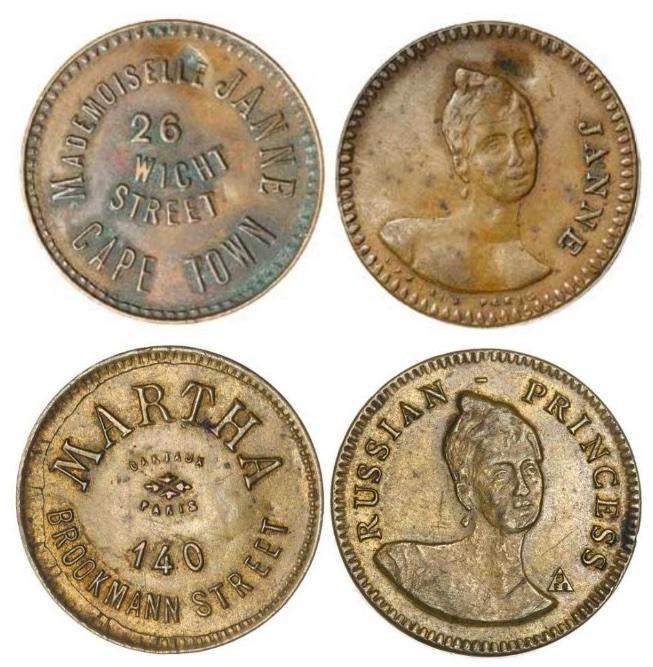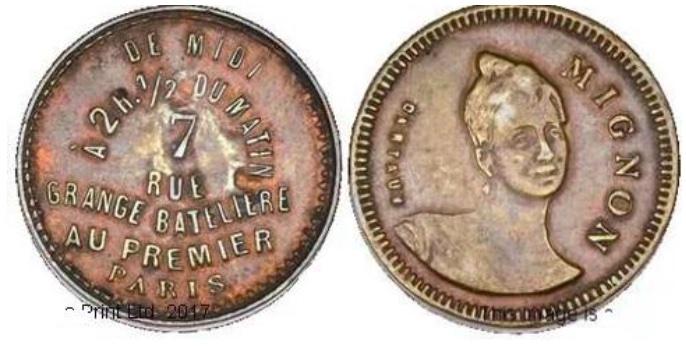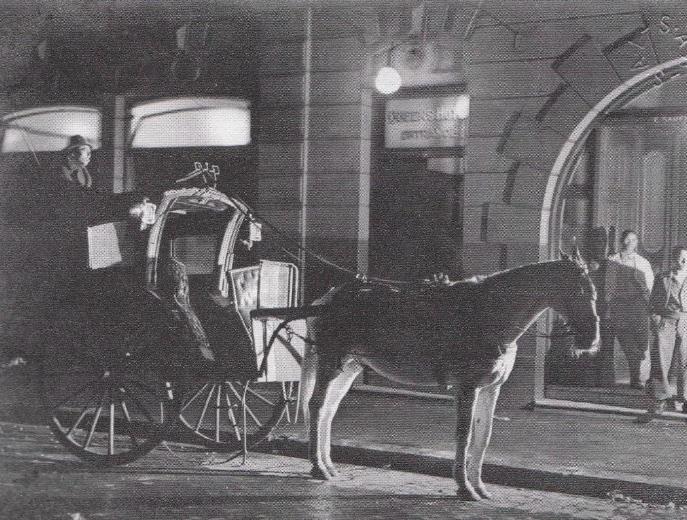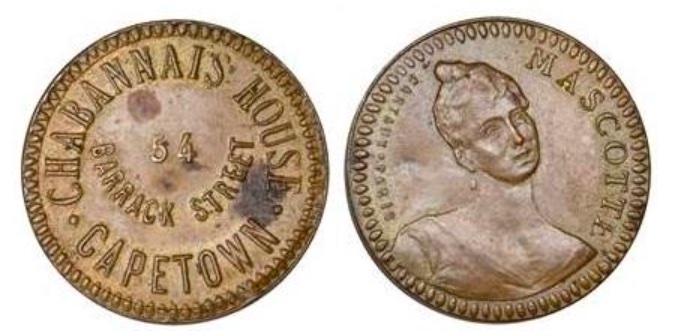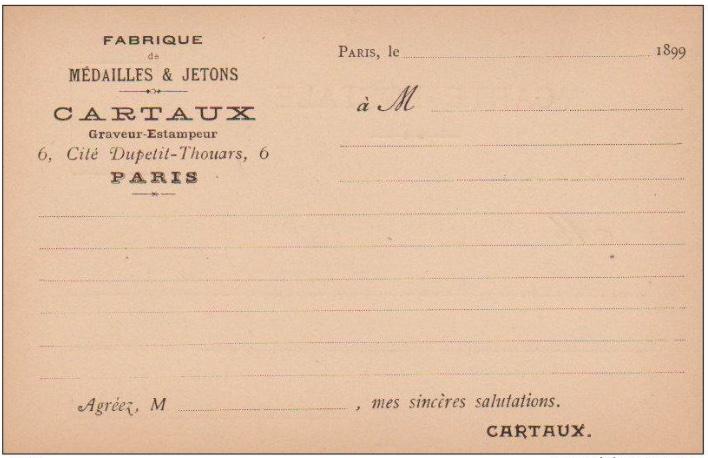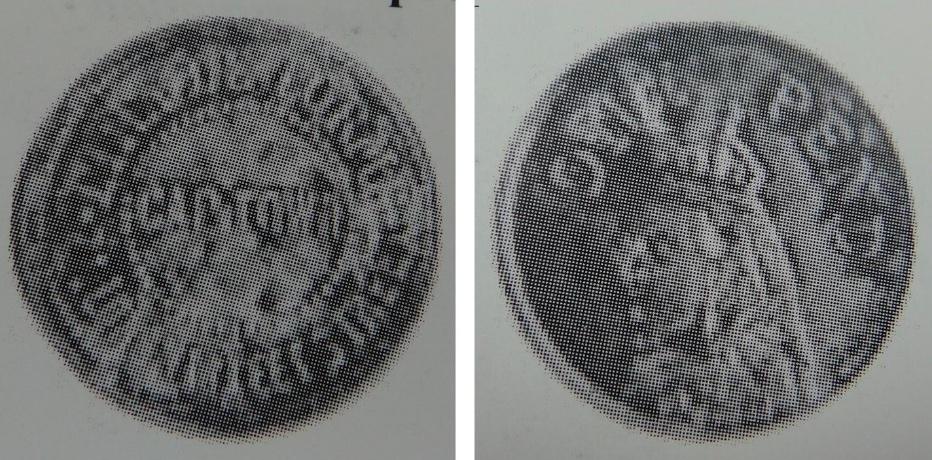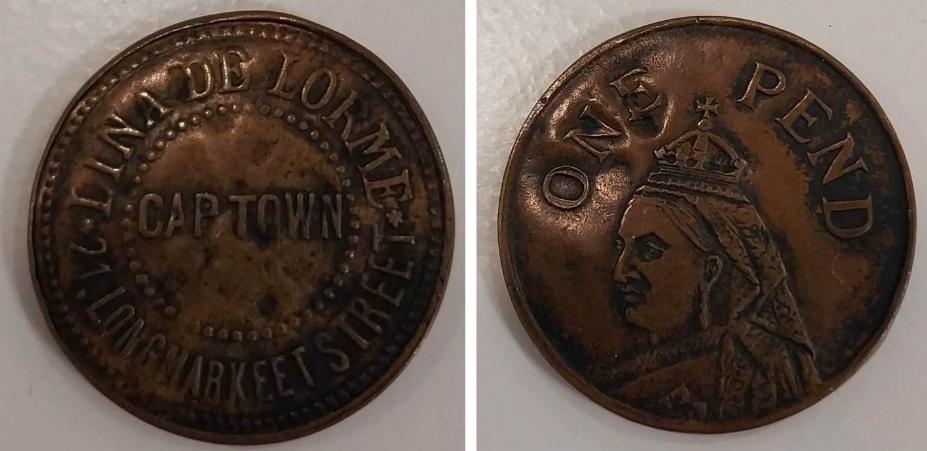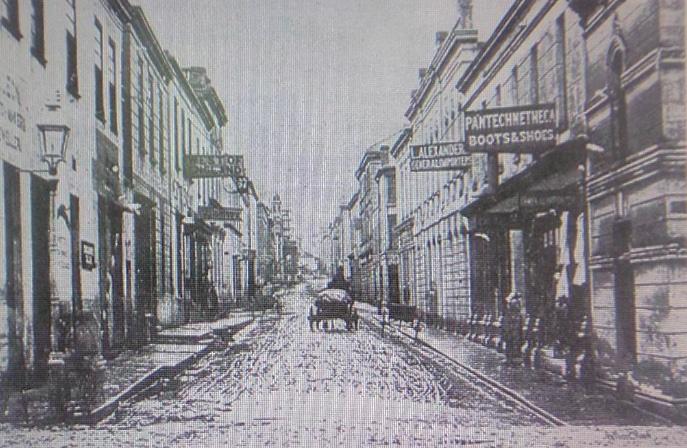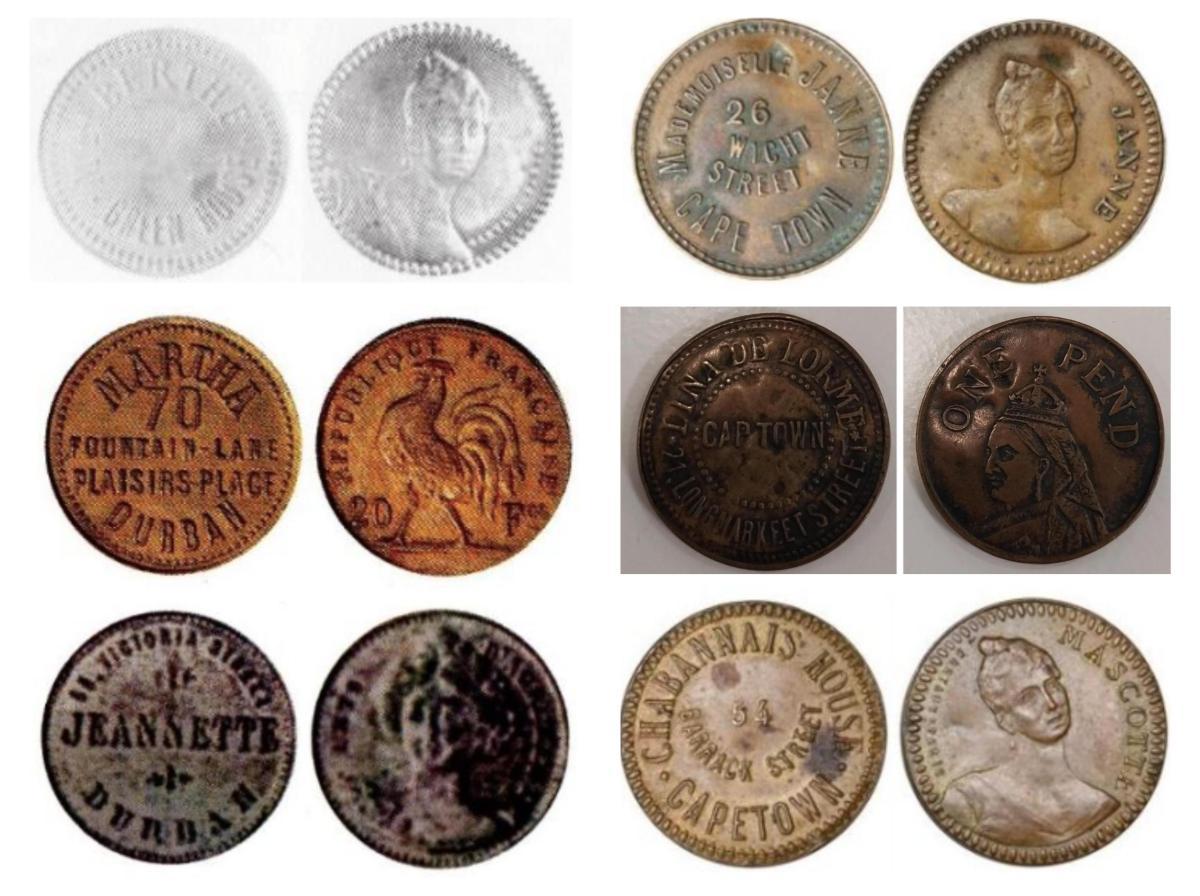
Disclaimer: Any views expressed by individuals and organisations are their own and do not in any way represent the views of The Heritage Portal. If you find any mistakes or historical inaccuracies, please contact the editor.
Both MTB South African Tokens (2021) and Hern’s Handbook on Southern African Tokens (2009) list six brothel tokens of which three were issued for use in Durban and the other three in Cape Town. These two port cities were the main entry points into Southern Africa for troops coming to fight in the Anglo-Boer War (1899-1902).
British troops disembarking at the Durban docks in 1899 (The South African Military History Society)
The tokens are the following: Berthe, Jeannette, Martha (Durban) and Mademoiselle Janne, Lina de Lorme, Mascotte (Cape Town).
Berthe (Hern’s Handbook on Southern African Tokens), Martha and Jeannette (MTB South African Tokens)
Janne (Noble Numismatics), Lina de Lorme (Hern’s Handbook on Southern African Tokens) and Mascotte (Noonan’s Mayfair)
As we shall see, with one exception, the tokens in most cases show clear similarities regarding their sizes, composition, place of manufacture (France) and maker, being Cartaux of Paris. In addition, their date of circulation being during the Anglo Boer war era and running into the early 1900s. However, one of the tokens clearly stands out as different to the others, and as the author will show, this token, although perceived as a South African brothel token by some leading South African token experts, does seems curiously out of place for reasons the author will discuss in the end section of this paper.
The one thing that all the token experts and catalogues agree on, is that they are all considered to be scarce and are seldom offered on the open market, and when they are, fetch high prices.
Lastly, very little has been written on these tokens in the past and information about them is truly scarce. Most of the information given in the paper is copied verbatim from a handful of sources being the following:-
- Articles written in the 1940s to the 1960s by Lt Colonel J.L. Knobel in South African numismatic publications as will be named in the text.
- Tokens of Southern Africa – a Catalogue based on the Collections in the Africana Museum compiled by E.J. Maynard in 1966.
- Hern’s Handbook on Southern African Tokens (2009).
- Tokens of the Colony and Province of Natal (2020) by Milner Snell that relates some earlier work by Pat Moran in his book The Tokens of Natal (1970).
- MTB South African Tokens (2021).
The Natal Brothel Tokens
In his book, Tokens of the Colony and Province of Natal (2020) by Milner Snell, he mentions that Pat Moran discusses the brothel tokens, also called soliciting tokens, in some detail in his book The Tokens of Natal. Regarding the three brothel tokens, he writes:
The brothel tokens were made of cardboard with a thin brass outer case. The manufacturers were Carteaux (sic) of Paris…the client would receive from the brothel-keeper a token in exchange for his money. This token was duly given to the girl of his choice and at the end of each day she would hand it in together with others she had received in order to be remunerated accordingly. It was believed that the cost of a brothel token was ten shillings or the equivalent of a soldiers pay for 10 days.
Moran identifies three houses of ill-fame that issued tokens: Berthe’s Jeanette’s and Martha’s.
1) Berthe
Berthe, known as Big Fat Berthe, ran a brothel in the Green House in Bond Street. The obverse shows the bust of a woman facing half right and reaching right down to the border of the piece. To the right of the bust, curved anti-clockwise in small capital letters “CARTAUX PARIS”. Reverse: Blank centre field. Curved above “MELLE BETHE”, separated by a dot on each side from “GREEN HOUSE” curved below. The edge of the piece is folded over and there is a pearled border of large elongated beads and a raised rim on both sides. Plain edges.
2) Jeannette
Jeannette operated from 68 Victoria Street. She was extremely attractive and fell in love with a young soldier whose job it was to inspect her premises daily. The soldier did not return her love and she eventually went back to France where she lived in poverty. The soldier and his wife sent her food parcels to sustain her. Description: Hollow brass. Obverse: Female bust facing to the front with on the left side ‘ARTS” and on the right “D’ AGREMENT”. Pearled border. Reverse: Across centre field “JEANNETTE” with a leaf motif above and below this. Curved above “68 VICTORIA STREET” and curved below “DURBAN”.
According to notes kept by the late Allyn Jacobs (and made available to the author by his fiend Steve van Niekerk), Jeanette was not a prostitute herself, but was in charge of the brothel. After the war she returned to France and retired to a convent. There she had an illegitimate child and died in poverty.
In an article written by J.L. Knobel in the South Africa Numismatic Journal Number 1 September 1964 (The Tokens of Southern Africa Coinage of Cape Town) he adds the following information: Diameter 21.4 mm. Thickness 1:7 mm. Weight 1.5 grams. Hollow brass. It has been surmised that these tokens were advertisement tokens of the Anglo-Boer War period, and were traded by pimps to soldiers and sailors in and around the docks. They are thought to have been made by Cartaux of Paris.
The token is also mentioned in Tokens of Southern Africa – a Catalogue based on the Collections in the Africana Museum compiled by EJ. Maynard in 1966.
3) Martha
Martha’s, the most famous of all the brothels in Durban, was situated at 70 Fountain Lane. It was well run and offered a pleasant and airy room in which clients could sit and wait their turn with the lady of their choice. Description: Obverse: Horizontally in three lines across centre field “70” “FOUNTAIN – LANE” “PLAISIRS – PLACE”. Curved above this “MARTHA” and below “DURBAN”. Reverse: A large strutting rooster occupies the whole centre field, standing on a mound. Curved around this “REPUBLIQUE FRANCAIS”. Below on the left “20” and on the right “Fcs”. A pearled border on both sides, but coarser on the obverse.
The token shows similarities to a French brothel token entitled Aux Belles Poules, which was a ‘maison close’ (brothel) that was built around 1904 in the Art deco style.
Regarding the Durban brothels in general, Allyn Jacobs in his notes records “It was the daily routine of the brothel girls to charter a fleet of rickshas each afternoon at a quarter to five. They would leave their various establishments, travel down Grey Street, along West Street, and then return home. The purpose of these daily pilgrimages is obscure but there’s little doubt they were eagerly awaited by the local soldiery. Though these houses of ill-fame derived most of their support from military and naval personnel, it was not uncommon for well-known dignitaries to frequent them in rickshas after dark”. (A ricksha, actually spelled rickshaw, is a small passenger vehicle with two wheels that is usually pulled by one person).
Riding a rickshaw in the Boer War period (Newark Advertiser)
The Cape Town Brothel Tokens
According to an article in The Cape Argus of 30 October 1999, the fairest Cape, as a port city and British military headquarters during the Anglo Boer War, “… was turned into the flirtiest Cape by troops searching for vice.” By the end of the war, the city was occupied by 600 full-time prostitutes known or listed by the police: 400 from continental Europe, 100 from Europe and 100 locals. Prostitution quadrupled during the course of the war and, by the time the guns had fallen silent, 150 brothels were operating in Cape Town.
1) Mademoiselle Janne
This token is first mentioned in an article by J.L. Knobel entitled “The Token Coinage of South Africa” in the South African Numismatic Society Magazine for 1947. Knobel erroneously spelled her name “Jeanne” and says it dates from the Anglo Boer War period. Knobel wrote some other articles on South African Tokens and again mentions the token in the South Africa Numismatic Journal Number 2 April 1965 (Part II, The Token Coinage of Cape Town). The following is copied verbatim from his article:
Soliciting token in hollow copper or bronze. Edge plain. Description: Obverse: Head and bust of woman facing half right. Legend: “JANNE” on the right side of the face. “CARTAUX PARIS” in small letters below bust. The entirety within a circle of elongated dots. Reverse: “26 WICHT STREET” in three lines across the field. Legend: “MADEMOISELLE JANNE” above. “CAPE TOWN” below. Again the entirety within a circle of elongated dots. Diameter 22.0 mm. Thickness 1.7 mm. Weight 1.6 grams.
These tokens, which are rare, were apparently handed by coloured pimps to soldiers and sailors at the dock’s gates as an advertisement of part of the pleasures of Cape Town! The story is told too, that on sunny afternoons the “ladies” would dress in their finery, and drive down Adderley Street in an open carriage distributing these tokens as “visiting cards” conveying the invitation to “come up and see me some time!” The old house at 26 Wicht Street still stands.
Adderley Street, Cape Town circa 1896. (Welcome Collection)
In November 2013, Noble Numismatics (Australia) sold one of these tokens for $180. Five years later, in 2018, the same company sold a very similar (but Australian) token for $850. It is described as “a brothel or soliciting token, Russian Princess, reverse Martha, 140 Brookmann Street, in brass covered cardboard, maker F. Castaux (Paris), claimed to be in Kalgoorlie c1900. Extremely fine and very rare. Ex David Baird Collection. Similar tokens were used in South Africa for the Anglo Boer War until 1917 ($450-500)”
The maker is actually Cartaux (not Castaux), who also made the Mademoiselle Janne token. The Australian token is shown below the South African one.
The following French brothel token from the same maker Cartaux, also show remarkable similarities to the above 2 tokens.
The caption to this old picture reads “A hansom cab delivering customers to the Queen’s Hotel, a waterfront tavern where sex workers plied their trade”. (Forgotten Cape Town – A visual history 1850-1950 by Tony Grogan)
2) Mascotte
The token is first mentioned in an article by J.L. Knobel entitled “The Token Coinage of South Africa” in the South African Numismatic Society Magazine for 1947. Knobel states that it dates from the Boer War period.
In Knobel’s article (previously mentioned) in the South Africa Numismatic Journal Number 2 April 1965 (Part II, The Token Coinage of Cape Town), he writes about this token:
Boer War Period. No value. Soliciting token. Made of Hollow Copper or Brass in the same style as those of Mademoiselle Janne and Durban’s Jeannette. Description: Obverse: Bust of a woman facing slightly right. Legend: “MASCOTTE” on the right of the bust. The whole within a circle of dots. “CARTAUX-PARIS” in tiny letters to left of head. Reverse: “54” in the centre of the field “BARRACK STREET” in a curve below the number. Legend: “CHABANNAIS HOUSE” above, divided by a dot on either side from “CAPE TOWN” below. The entirety within a circle of dots. Dimensions: Diameter 21.9 mm. Thickness 1.7 mm. Weight 1.5 grams. Made of hollow copper or brass by Cartaux of Paris who were the makers of the similar Mademoiselle Janne token and also possibly the Jeannette token of Durban.
Visiting card dated 1899 of Cartaux of Paris, makers of medals and tokens (Numista)
This token which is rare, only a few specimens being known, was undoubtedly used in a similar manner to the other two tokens of a like nature that is as an advertisement piece to be handed out by pimps at the dock’s gates and the railway station to soldiers and sailors on active service in the Anglo-Boer War. Chabannais House was also a brothel. It is not known whether it is the same address as No. 54 Barrack Street. Any information from any book of the period or old newspapers etc. would be appreciated by the author. Very little seems to have been recorded about these places. Present day newspapers are less reticent about these matters and odd court cases concerning brothels are now given plenty of prominence.
This token is also mentioned in Tokens of Southern Africa – a Catalogue based on the Collections in the Africana Museum compiled by EJ. Maynard in 1966. Maynard adds that in the South African Directory of 1903, Miss Mascot, 54 Barrack Street, is listed. There is no listing in 1906. The current Department of Home Affairs Cape Town, is situated next door at number 56, Barack Street.
Mr. Clive Page describes the token in an article entitled 'Tokens relating to the Cape' (The South African Numismatic Society 60th Anniversary Journal dated 2001). He says that during the Boer War period, it would appear that the brothel keeper handed the tokens to her pimp who passed them on to prospective clients at the docks. He says that Barrack Street was formerly known as Zieke Dwaars (Dwars?) Straat.
3) Lina de Lorme
This is the token that we referred to in the introduction and stated that it “does seems curiously out of place for reasons the author will discuss in the end section of this paper…” As far as we could ascertain, only two pictures of this token exists, those being published in Hern’s Handbook on Southern African Tokens (2009) and MTB South African Tokens (2021).
The last mentioned records: “This piece differs markedly from the other known brothel tokens from Cape Town and Durban, so it is unlikely it was also manufactured in France. The only known specimen is in the Absa Museum. They purchased it on auction perhaps 20 years ago”. It also states that the pictures illustrated are a photocopy from a book. (We actually believed both catalogue’s pictures are the same picture and this was later confirmed by Steve van Niekerk, who co-authored MTB South African Tokens (2021) with Dr. Carroll and the late Allyn Jacobs).
The black and white picture is very unclear with some words hardly legible.
According to Allyn Jacobs’ notes, the token was offered by “Owen” on a postal auction in 1993 and again in 1996 when it was bought for the Absa museum. (We believe Jacobs is referring to the late Colin R. Owen who for many years ran Chimperie Agencies' Postal Auctions in Somerset West).
We have subsequently written to Dr. Paul Bayliss of the Absa museum asking for clearer pictures of the token, and on 9 January received colour pictures of it from Genevieve Ray of the museum.
From this picture, all the words are clear and readable. The copper token actually looks “hollow” as there are press marks on both sides. The obverse shows the crowned effigy of Queen Victoria with the words ONE PEND. Coin collectors will know that the Victorian coins of Great Britain, due to her long reign, that three different effigies of the queen are displayed, fondly being called the “Young Face”, “Veiled Face” and “Old Face” wearing a crown. The latter showing similarities with the token which probably dates from the late 1800s.
The reverse reads “LINA DE LORME” and “21 LONGMARKEET STREET” with “CAPTOWN” in the middle within a beaded circle.
The spelling mistakes are clear being LONGMARKEET (for Longmarket), CAPTOWN (for Cape Town) and the word “PEND” on the obverse is nonsensical. If the word indicates a Penny denomination this would be even more confusing as the brothel visiting cost at that stage was ten shillings (equaling 120 Pennies) as we shall see. A penny in late Victorian times does not even equites to R10 today.
A picture of Longmarket Street in mid-Victorian times described as a “slum” although it does not appear that way (UCT Macmillan Archive)
We have done some research on the address depicted on the token being 21 Longmarke(e)t street.
In Bo-Kaap Architecture: a Critique of Structuralist Theory (1991) by Joanna Behrens, the address is described as:
BK90/26 (21 Longmarket Street) 'Masondale' - plan obtained through the City Council - since demolished. This was a single storey, 'late-Victorian' house. The entrance was set between two bay windows. It had plaster quoining and a simple cast iron verandah (Fransen and Cook 1980:66) … Deeds research (Appendix 1) indicates 'Masondale' was built in the last decade of the nineteenth century (c1899); its rapid deterioration suggests poor architectural quality.
The thesis later on also mentions that the owner between 1987 and 1902 was a Charles C. Mason.
However, it appears that Behrens, in her study, confused number 21 Longmarket Street with 212 Longmarket Street or it was simply a typing error: - She refers to BK90/26 seven times and in five of the cases the address is given as 212 Longmarket Street and only twice as 21 Longmarket Street. As a matter of interest, 212 Longmarket Street is historically a so-called Coloured area in the Bo-Kaap which is the focus of her study. While the address depicted on the token (21 Longmarket Street) is on the other side of the central business district not far from the Cape Castle. It is in fact only 3 blocks away from Barrack Street where the “Mascotte” brothel was situated.
According to Corina González-Stout (in a doctoral thesis entitled 'Carnal Vigilance, Vending Vice: Race, Gender and Sexual Commerce in Cape Town, 1868-1957'), there was a Marianne DeLorne, age 26, working in two brothels in Cape Town, the one situated at 28 Longmarket Street. It belonged to a Polish-born American gangster, Joseph Lis (alias Joe Silver) whose girlfriend, Annie Bloem managed the two brothels at the beginning of the previous century. There was also a brothel at 56 Longmarket Street, but its ownership is not known. The cost of visiting Annie Bloem’s brothel in Longmarket Street is recorded as ten shillings (the reader shall remember than in the section on Natal tokens, the amount mentioned was exactly the same).
In the General Directory and Guide Book to the Cape of Good Hope for 1886, the names of William C Bray as a hotelkeeper and George Clayton, a builder, are given as occupants of 21 Longmarket Street. Was the hotel perhaps used as a brothel during the period? We can only surmise.
Secondly, why would a brothel depict the effigy of a crowned regal queen on its tokens? Given the era, its prudishness and rectitude; this would be especially strange when brothel keeping would probably have been highly illegal and certainly would not be associated with the venerable monarch? In addition, why all the spelling mistakes on the token and why the strange denomination?
Could it all have been done deliberately in an attempt to preempt the brothel keeper from possible prosecution with the defence that there is no street in Cape Town called Longmarkeet and that there is not even a place called Captown and that one pend is not a coin denomination?
This is of course based on the assumption that it was indeed a brothel token as it could also have been a pattern of some type to be used by other legal businesses in Cape Town. The spelling errors could also have been due to it being produced in a foreign country where the die-maker was not proficient in English.
We simply do not know - yet. We have many questions, but few answers – possibly some of our readers have alternative thoughts which they could share with us. We would welcome such.
Pierre Nortje is the secretary of the Western Cape Numismatic Society
Comments will load below. If for any reason none appear click here for some troubleshooting tips. If you would like to post a comment and need instructions click here.

